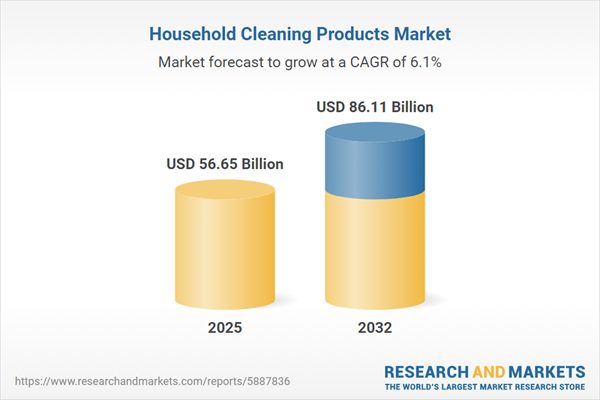Speak directly to the analyst to clarify any post sales queries you may have.
The household cleaning products market is evolving rapidly, shaped by shifting regulatory demands, sustainability priorities, and customer expectations. Senior decision-makers face increasing pressure to lead responsibly, ensuring future readiness through innovation and operational agility across their organizations.
Market Snapshot: Household Cleaning Products Market Trends and Growth Dynamics
The household cleaning products market reached a value of USD 53.42 billion in 2024, registering a compound annual growth rate of 6.14%. Growth reflects heightened global awareness around hygiene standards, stronger focus on public health, and more stringent environmental regulations. Senior executives are driving change by developing sustainable product lines, accelerating digital transformation, and embedding next-generation technology into core operations. Companies are reformulating products for environmental responsibility, embracing ethical sourcing, and customizing solutions for diverse consumer and business segments. This results in a competitive environment that rewards transparency, adaptability, and innovative digital business models that foster customer loyalty and operational resilience.
Scope & Segmentation: Key Drivers in the Household Cleaning Products Market
Strategic segmentation and a clear view of core market drivers are fundamental for executives aiming to secure value and mitigate risk in a challenging landscape. The following market segments illustrate where innovation and differentiation are essential:
- Product Types: Air fresheners, dishwashing detergents for both manual and machine use, advanced laundry formulations, and next-generation surface cleaners. Each group addresses specific residential and commercial use-cases, allowing tailored innovation and delivery of targeted solutions.
- Distribution Channels: Digital commerce, supermarkets, hypermarkets, convenience stores, specialty wholesalers, and robust e-commerce offerings. Broader channel access enables organizations to maximize reach and strengthen engagement in consumer and institutional markets.
- End Users: Serving households, healthcare organizations, hospitality providers, industrial applications, and government agencies. Each brings unique standards for compliance, sustainability, and performance, requiring agile product and service adaptation.
- Product Forms: Liquids, powders, tablets. Offering a variety of forms supports sustainability objectives, enhances supply chain efficiency, and accommodates changing user preferences across different markets and applications.
- Regional Coverage: Americas, Europe, Middle East, Africa, Asia-Pacific. Navigating local regulatory environments and cultural preferences ensures market relevance and enables the formation of strong, regionalized strategies and partnerships.
- Competitive Landscape: Leading organizations such as Procter & Gamble, Unilever, Henkel, Reckitt Benckiser, SC Johnson, Clorox, Colgate-Palmolive, Church & Dwight, Kao, and Lion set the standard in supply chain resilience, responsible sourcing, and technology integration.
Household Cleaning Products Market: Key Takeaways for Senior Executives
- Integrating sustainability into supplier relationships is reducing the environmental impact throughout sourcing, manufacturing, and distribution workflows.
- Implementing digital and automated solutions increases responsiveness and supports real-time adaptation amid rapidly changing market requirements.
- Improving ingredient transparency and using recyclable packaging are reinforcing customer and regulatory trust, enabling stronger competitive positioning.
- Advanced quality management programs and bespoke solutions for healthcare, hospitality, and industrial buyers are elevating service levels and spurring ongoing product innovation.
- Collaboration across the supply chain enhances reliability, helping organizations address challenges faced in both mature and emerging regions.
- Continuous innovation, aligned with regional market adaptations, positions companies to capture new growth opportunities and strengthen market resilience.
Tariff Impact and Strategic Response
- Alterations in US import tariffs drive an emphasis on regional sourcing and expansion of domestic manufacturing, which helps ensure stable cost management and reliable supply chains.
- Adopting regional pricing models and developing localized product lines improve competitiveness and allow faster response to evolving regulatory requirements.
- Proactive engagement with government agencies and regulators boosts compliance efficiency, minimizing risks linked to global trade disruptions.
Methodology & Data Sources
This report draws on public corporate disclosures, direct interviews with senior executives, and technical assessments, reviewed against retail sales data and validated by industry authorities. The resulting analysis offers senior leaders robust, actionable guidance for strategic decision-making.
Why This Report Matters
- Provides senior executives with actionable segmentation and insight to identify investment priorities and optimize go-to-market approaches.
- Supports digital transformation initiatives and streamlines compliance management in a tightly regulated sector.
- Delivers practical recommendations for maintaining operational stability, mitigating risk, and building sustainable market resilience.
Conclusion
Senior decision-makers gain the clarity and direction needed to achieve alignment, manage risk, and support organizational growth in a market defined by rapid evolution. Strategic flexibility will be essential for long-term success.
Additional Product Information:
- Purchase of this report includes 1 year online access with quarterly updates.
- This report can be updated on request. Please contact our Customer Experience team using the Ask a Question widget on our website.
Table of Contents
3. Executive Summary
4. Market Overview
7. Cumulative Impact of Artificial Intelligence 2025
Companies Mentioned
The companies profiled in this Household Cleaning Products market report include:- Procter & Gamble Company
- Unilever PLC
- Henkel AG & Co. KGaA
- Reckitt Benckiser Group plc
- SC Johnson & Son, Inc.
- The Clorox Company
- Colgate-Palmolive Company
- Church & Dwight Co., Inc.
- Kao Corporation
- Lion Corporation
Table Information
| Report Attribute | Details |
|---|---|
| No. of Pages | 185 |
| Published | October 2025 |
| Forecast Period | 2025 - 2032 |
| Estimated Market Value ( USD | $ 56.65 Billion |
| Forecasted Market Value ( USD | $ 86.11 Billion |
| Compound Annual Growth Rate | 6.1% |
| Regions Covered | Global |
| No. of Companies Mentioned | 11 |









